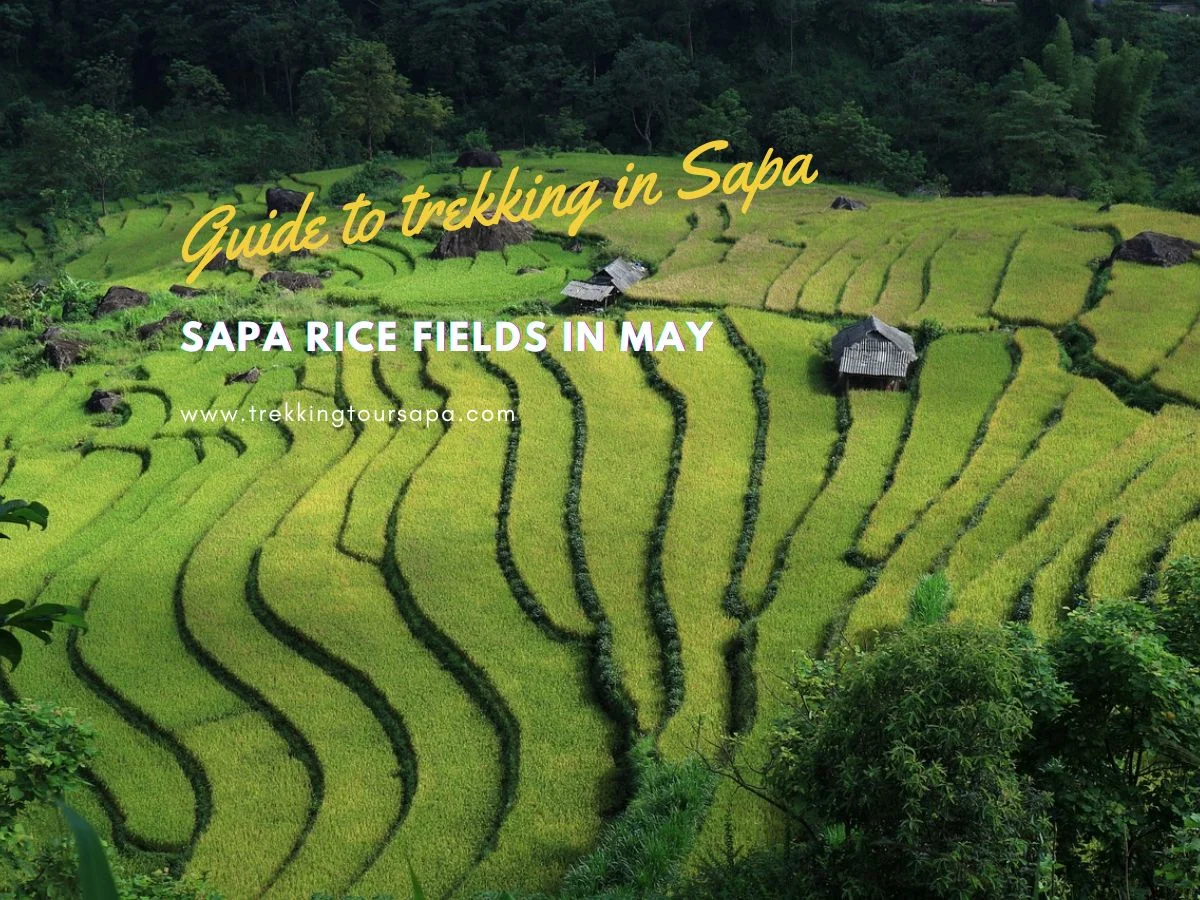Looking for a destination that will take your breath away and offer a sense of freedom? Look no further than Sapa, Vietnam in May. This is the perfect time to visit the beautiful rice fields that have made Sapa famous. As you trek through the vibrant green landscape, you’ll feel like you’ve been transported to another world.

The rainy season brings out the best in these rice paddies and makes them even more stunning than usual. The waterlogged terrain creates an otherworldly environment that is both surreal and awe-inspiring. And with colorful flowers blooming throughout the fields, you’ll be surrounded by a natural beauty that is hard to find anywhere else in the world. So pack your bags, grab your camera, and get ready for an adventure unlike any other in Sapa‘s breathtaking rice fields.
Table of Contents
ToggleThe Beauty of Sapa Rice Fields in May
Experience the breathtaking allure of nature’s vibrant and lush green landscapes during this time of year, as you immerse yourself in the beauty of Sapa rice fields in May. The stunning scenery will leave you mesmerized, with endless rows of terraced rice paddies stretching out before you like a sea of emerald green.

As you explore these gorgeous fields, take advantage of the perfect photography opportunities that abound at every turn. Learn from local experts about their unique photography techniques to capture the essence of this magical place. And when it comes time to refuel, indulge in some delicious local cuisine that perfectly complements your surroundings. From the freshest vegetables grown right here in Sapa to savory meats and aromatic spices, every dish is a true delight for your taste buds.
Now let us delve into the significance of the rainy season and how it impacts these magnificent fields without missing a beat.
The Significance of the Rainy Season
The arrival of the monsoon brings life back to the parched earth, nourishing it with a downpour that echoes through the hills. The rainy season is crucial for the rice fields in Sapa, as they rely on irrigation to grow and thrive. Without this replenishment from nature, crop yields would suffer, and sustainability would be compromised.
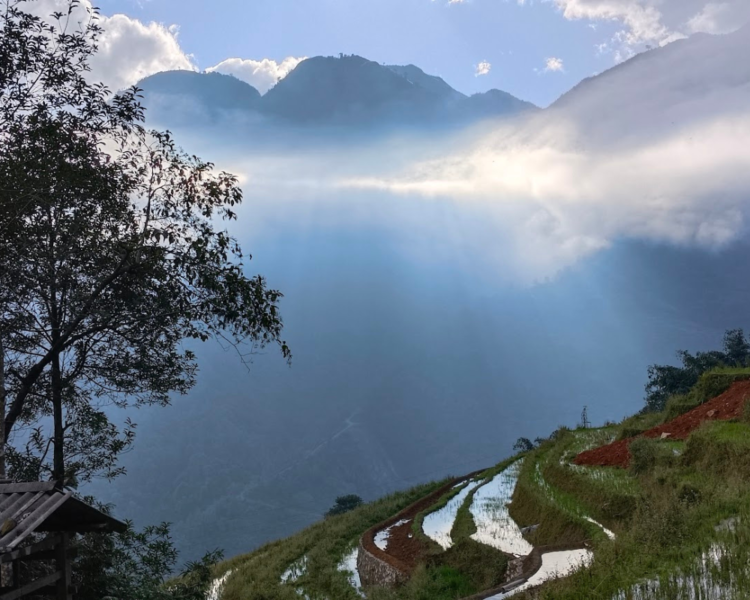
To truly appreciate the significance of the rainy season, imagine standing in a field surrounded by vibrant green stalks of rice. Now picture this same landscape during a drought – dry, cracked soil with stunted plants struggling to survive. This stark contrast highlights just how important irrigation is for these crops and why farmers must carefully manage their water resources. The sight of lush rice paddies stretching out before you after a good rainfall is not only beautiful but also a testament to the hard work and dedication required for sustainable agriculture.
With these thoughts in mind, let’s move on to exploring another aspect of Sapa’s rice fields – the vibrant colors that adorn them during May’s harvest season.
The Vibrant Colors of the Rice Paddies
Get ready to witness a stunning display of nature’s palette as the hills come alive with an explosion of colors during harvest season. The sapa rice fields in May offer the most vibrant and colorful landscapes you will ever see. As the rainy season ends, the water levels in the paddies recede, leaving behind layers of mud and lush greenery. This creates a stark contrast against the golden hues of ripening rice plants that sway in the gentle breeze.

To truly appreciate this natural wonder, take a moment to sit back and marvel at how seasonal changes transform these terraced hills into a work of art. As you take in the breathtaking scenery, consider capturing it through photography. With careful composition and attention to detail, your photographs can transport others to this serene location long after you have left.
Photography Tips for Capturing the Best Shots
You’ll want to have your camera ready and be prepared to snap away as the vibrant hues of nature’s canvas come alive in front of you, capturing every detail from the layers of mud and greenery to the golden ripening rice plants gently swaying in the breeze. To make your photos stand out, try incorporating composition techniques such as leading lines or framing elements within the landscape. Experiment with different lighting strategies by shooting during different times of day; early morning or late afternoon light can create stunning backlighting effects.

As you immerse yourself in this breathtaking scenery, don’t forget to pay attention to small details that can add depth and interest to your images. Capture shots of farmers at work, water buffalo grazing along the banks, or even a single blade of grass waving in the wind. With some creativity and patience, you’ll be able to capture stunning photographs that truly showcase the beauty of Sapa’s rice fields. Now let’s talk about weather considerations when planning your trip.
Sapa 1 Day Tours
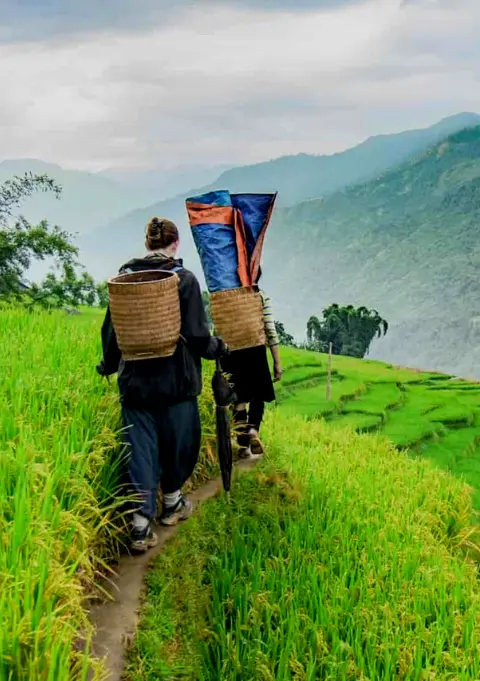
- 1 day experience
- Moderate to challenging
- Cultural immersion & active adventure
- Rice fields, valleys & villages
- Private tours
- Vegan-friendly
Sapa 2 Day Tours
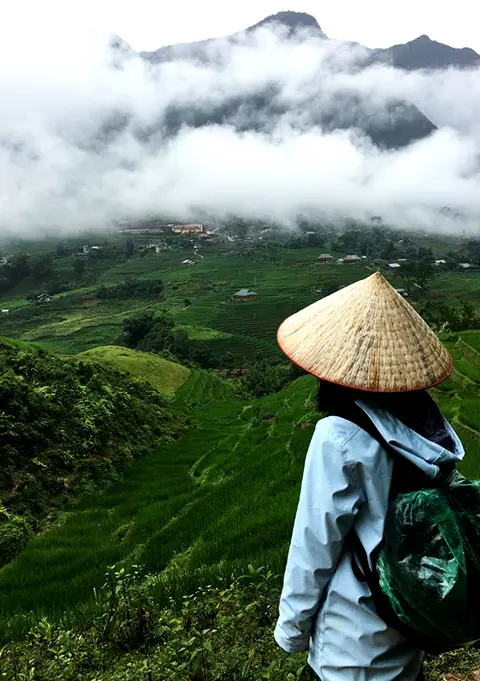
- 2 days 1 night experience
- Moderate to challenging
- Cultural immersion & active adventure
- Mountains, valleys, rice fields and villages
- Private tours
- Vegan-friendly
Sapa 3 Day Tours
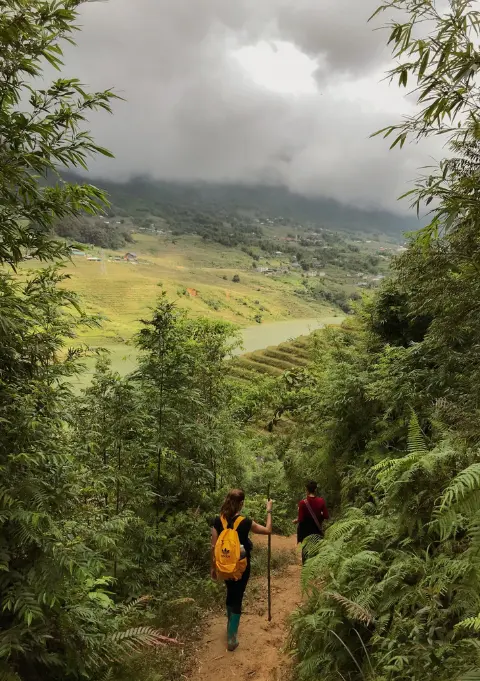
- 3 days 2 night experience
- Moderate to challenging
- Cultural immersion & active adventure
- Mountains, valley, rice fields & villages
- Private tours
- Vegan-friendly
Sapa 4 Day Tours
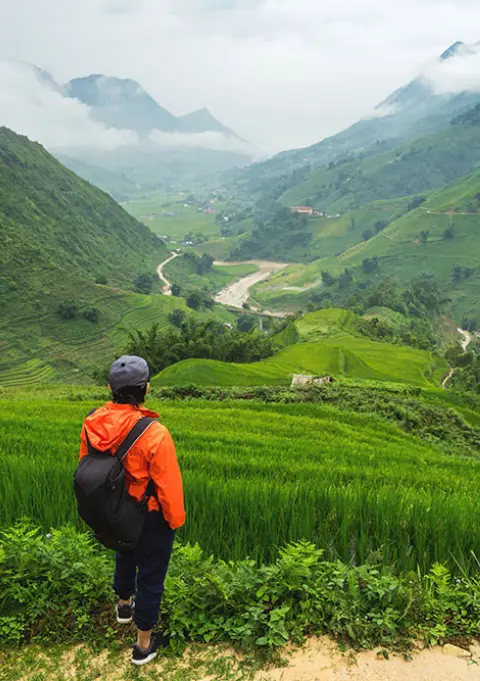
- 4 days 3 night experience
- Moderate to challenging
- Cultural immersion & active adventure
- Mountains, valleys, rice fields & villages
- Private tours – Less Touristic
- Vegan-friendly
Weather Considerations
When it comes to capturing stunning photographs in Sapa’s rice fields, the weather is a crucial consideration. You’ll want to keep in mind the unpredictable weather patterns that can arise, especially during the rainy season. Be sure to prepare for rain and mist by bringing appropriate gear and adjusting your shooting techniques accordingly. With these tips in mind, you’ll be better equipped to capture beautiful images of this enchanting destination regardless of what the weather might throw your way.
Unpredictable Weather Patterns
You never know what kind of weather to expect during this time of year, which can make planning your outdoor activities a bit tricky. Climate change effects have caused unpredictable weather patterns that affect everything from farming techniques to tourism. The sapa rice fields in May are no exception. While you may be tempted to visit during this month for the lush green scenery, keep in mind that May is considered part of the rainy season in Vietnam.

Rain and mist can be expected during your visit, but don’t let that deter you from experiencing the beauty of these rice fields. In fact, the rain and mist add an ethereal quality to the landscape that cannot be replicated on a sunny day. Just make sure to pack appropriate rain gear and be prepared for slightly slippery terrain. Now let’s talk about how to prepare for rain and mist during your trip to sapa rice fields in May.
Preparing for Rain and Mist
Get ready for the rainy season by packing rain gear essentials such as waterproof jackets, pants, and boots. The weather in May can be unpredictable with frequent rain and mist, so it’s important to come prepared. Embrace the ethereal beauty that comes with misty weather in Vietnam by exploring the hiking trails in Sapa. The landscape is transformed into a mystical wonderland as the fog rolls through the rice fields and mountains.

While it may be tempting to stay inside during wetter days, don’t let it deter you from experiencing all that Sapa has to offer. The lush greenery that blankets the region is at its most vibrant during this time of year, making it an ideal time for nature lovers to visit. As you trek through the winding paths, take note of how each step creates a symphony of sounds – from crunching leaves underfoot to trickling waterfalls nearby. With proper preparation and an open mind, you’ll find that even rainy days have their own unique charm in Sapa.
With your rain gear packed and your adventurous spirit ignited, get ready to dive into cultural experiences in Sapa without missing a beat!
Cultural Experiences in Sapa
Experience the rich cultural heritage of Northern Vietnam through unique and immersive activities in the stunning highlands. Sapa is known for its cultural immersion opportunities, where you can learn about traditional customs and practices of the ethnic minority groups who call this region home. Take a cooking class and learn how to prepare local cuisine using fresh ingredients sourced from the rice fields. You’ll gain insight into the culinary traditions passed down through generations while enjoying a delicious meal.

Participate in a homestay with a local family to learn more about their daily life and customs. You’ll have the opportunity to help with farm work, such as harvesting rice or tending to livestock, gaining an appreciation for the hard work that goes into sustaining life in this rugged terrain. Immerse yourself in their culture by joining them in traditional dances or learning how to play their musical instruments. These experiences will leave you with a deeper understanding and appreciation for this unique part of Vietnam.
As you continue your journey through Sapa, don’t forget to explore all of the outdoor activities available here.
Outdoor Activities in Sapa
As you immerse yourself in the cultural experiences of Sapa, don’t forget to explore the natural beauty that surrounds you. If you’re craving adventure and a chance to stretch your legs, there are plenty of outdoor activities available in this picturesque region. From trekking through vibrant green rice fields to indulging in local cuisine, there’s no shortage of things to do.

One of the most popular outdoor activities in Sapa is trekking, and it’s easy to see why. With stunning views at every turn, you’ll be able to explore beautiful trekking routes that will leave you breathless both from exertion and scenery. You’ll also have the chance to interact with locals along the way and experience their unique way of life up close. After a long day on your feet, treat yourself to some delicious local cuisine like pho cuon or thang co – hearty and filling dishes that will give you all the energy you need for your next adventure.
As you plan your trip to Sapa, remember that there’s more than just culture waiting for you here. The great outdoors is calling your name, so make sure to pack accordingly and get ready for an unforgettable journey into nature.
Sapa 1 Day Tours

- 1 day experience
- Moderate to challenging
- Cultural immersion & active adventure
- Rice fields, valleys & villages
- Private tours
- Vegan-friendly
Sapa 2 Day Tours

- 2 days 1 night experience
- Moderate to challenging
- Cultural immersion & active adventure
- Mountains, valleys, rice fields and villages
- Private tours
- Vegan-friendly
Sapa 3 Day Tours

- 3 days 2 night experience
- Moderate to challenging
- Cultural immersion & active adventure
- Mountains, valley, rice fields & villages
- Private tours
- Vegan-friendly
Sapa 4 Day Tours

- 4 days 3 night experience
- Moderate to challenging
- Cultural immersion & active adventure
- Mountains, valleys, rice fields & villages
- Private tours – Less Touristic
- Vegan-friendly
Planning Your Trip to Sapa
You’ll want to start planning your trip to this stunning region now that we’ve covered the outdoor activities, so let’s dive into some helpful tips for making the most of your visit. When choosing accommodation options in Sapa, you can either opt for a homestay with a local family or book a hotel room in town. Homestays offer an authentic experience and allow you to immerse yourself in the local culture, while hotels provide more privacy and comfort.
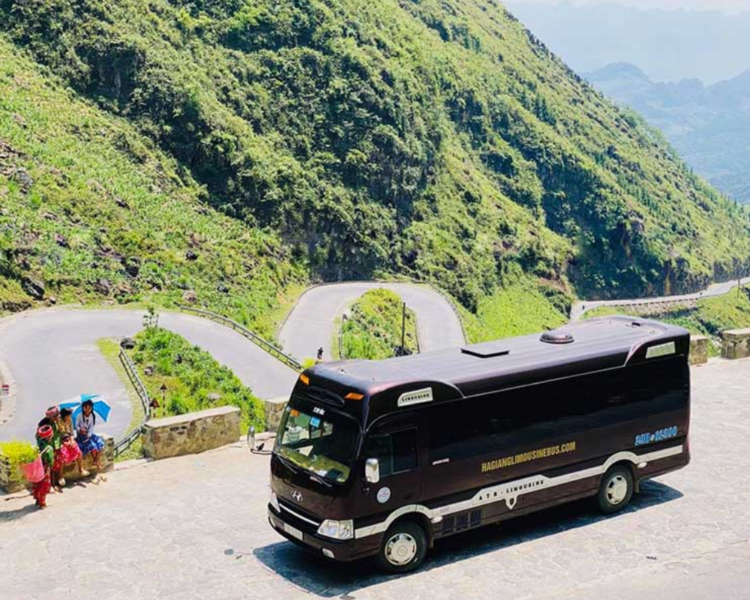
Transportation choices are also important when planning your trip to Sapa. You can take a bus from Hanoi or rent a motorbike if you’re feeling adventurous. However, keep in mind that the roads leading up to Sapa can be winding and steep, so it’s essential to drive with caution. Alternatively, you can hire a private car or join a tour group if you prefer not to drive yourself. With these tips in mind, you’ll be well on your way to experiencing all that Sapa has to offer!
Sapa Rice Fields In May Frequently Asked Questions
What is the history of rice farming in Sapa?
Have you ever wondered about the history of rice farming in Sapa? It’s a subject that has been debated by scholars for years, with some arguing that the practice dates back to ancient times while others claiming it was introduced by Chinese immigrants. Regardless of its origins, one thing is certain: rice farming has played a significant role in the cultural significance of Sapa and its people. Traditional farming techniques are still used today, such as terrace cultivation on steep hillsides and the use of water buffalo for plowing. These methods not only preserve the authenticity of this beautiful region but also serve as a reminder of its rich agricultural heritage. As you explore Sapa’s rice fields in May, take note of these techniques and appreciate the dedication of those who continue to maintain them.
How do the locals prepare and cook their rice dishes?
If you’re interested in local rice recipes and how they are prepared, you’ll be amazed by the techniques used by the locals. They have been harvesting rice for generations using traditional methods that involve planting, cultivating, and harvesting the crop. Once harvested, they clean it thoroughly before cooking it with a variety of ingredients such as herbs, vegetables, and spices. The dishes are not only delicious but also nutritious and provide a sense of comfort to those who eat them. As you explore the region’s culinary offerings, you’ll find that each dish has its own unique flavor profile that reflects the culture and history of this beautiful area. Whether you’re looking for something savory or sweet, there’s sure to be a local rice recipe that will tantalize your taste buds and satisfy your soul.
Are there any endangered plant or animal species in the rice fields?
Biodiversity preservation is a critical issue that requires conservation efforts to protect endangered plant and animal species. The destruction of natural habitats has led to the extinction of numerous species, making it essential to prioritize the protection of our ecosystems. Many regions are implementing conservation efforts, such as safeguarding biodiversity hotspots and creating protected areas for threatened species. It’s important to recognize the value that each living organism brings to our planet and take action towards protecting their survival. By doing so, we can ensure a sustainable future for ourselves and generations to come.
What is the economic impact of rice farming on the local community?
Rice farming has a significant economic impact on local communities, as it is often a major source of income for many households. The sustainability of rice farming practices is crucial to maintaining the long-term viability of this industry. Market demand plays a significant role in determining the success of rice farmers, as fluctuations in supply and demand can greatly affect the price they receive for their crops. The community benefits from rice farming not only through direct economic means but also through cultural traditions and heritage that have developed around this agricultural practice. It’s important to consider the social and environmental impacts of rice farming, along with its economic potential, to ensure that local communities continue to thrive while preserving their unique way of life.
How has climate change affected the rice fields in recent years?
You’ve noticed the changing climate patterns, haven’t you? The earth is getting warmer each year and it’s affecting everything around us. Rice production, one of the largest industries in many countries, has been greatly impacted by this change. The farming techniques used for centuries are no longer enough to keep up with the increasingly unpredictable weather patterns. Floods and droughts are becoming more frequent and severe, creating a challenging environment for rice farmers. To combat this, new techniques have been developed that are more resilient to these changes. But even with these developments, there’s still uncertainty about what the future holds for rice farming and its impact on local communities. As we strive towards a more sustainable future, it’s important to keep in mind the role that rice farming plays in our world and how we can adapt to ensure its continued success while also preserving our planet’s resources.
Conclusion
So, you’re convinced that a trip to Sapa in May is the perfect holiday destination for you. You’ve read about the significance of the rainy season and how it brings out the vibrant colors of the rice paddies. You’ve also learned about some photography tips to help capture those Instagram-worthy shots.
But what about experiencing the culture and outdoor activities that Sapa has to offer? Imagine hiking through terraced hillsides while taking in breathtaking views of the valleys below. Or immersing yourself in local traditions by visiting a nearby village and learning from its inhabitants.
The possibilities are endless, and there’s no better time than now to start planning your trip. So pack your bags, grab your camera, and get ready for an adventure that will leave you with memories to last a lifetime. The beauty of Sapa rice fields in May awaits you!
Sapa 1 Day Tours

- 1 day experience
- Moderate to challenging
- Cultural immersion & active adventure
- Rice fields, valleys & villages
- Private tours
- Vegan-friendly
Sapa 2 Day Tours

- 2 days 1 night experience
- Moderate to challenging
- Cultural immersion & active adventure
- Mountains, valleys, rice fields and villages
- Private tours
- Vegan-friendly
Sapa 3 Day Tours

- 3 days 2 night experience
- Moderate to challenging
- Cultural immersion & active adventure
- Mountains, valley, rice fields & villages
- Private tours
- Vegan-friendly
Sapa 4 Day Tours

- 4 days 3 night experience
- Moderate to challenging
- Cultural immersion & active adventure
- Mountains, valleys, rice fields & villages
- Private tours – Less Touristic
- Vegan-friendly
